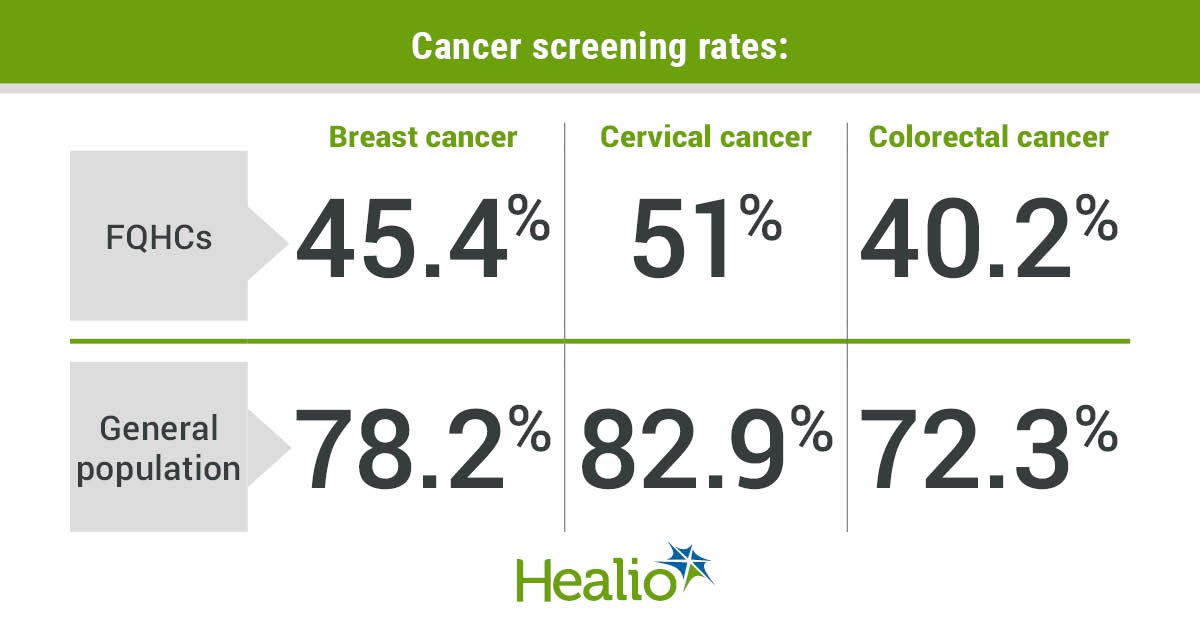Key takeaways:
- Breast, cervical and colorectal cancer screening was low in federally qualified health centers vs. general population.
- Increasing screening in these centers could improve rates for racial and ethnic minorities.
Federally qualified health centers reported substantially lower breast, cervical and colorectal cancer screenings compared with the general U.S. population, highlighting a gap in screening rates for adults from underrepresented groups.
Often, uninsured, medically underserved and racially and ethnically minoritized populations receive health care services from safety-net settings, such as federally qualified health centers (FQHCs), Trisha L. Amboree, PhD, MPH, postdoctoral fellow in the department of behavioral science at The University of Texas MD Anderson Cancer Center, and colleagues wrote.
Data were derived from Amboree TL, et al. JAMA Intern Med. 2024;doi:10.1001/jamainternmed.2024.0693.
“FQHCs are important safety nets that provide health services to roughly 30 million people in the U.S. These centers play a critical role in providing cancer prevention services including breast, cervical and colorectal cancer screenings,” the researchers wrote. “However, financial constraints, limited resources and staff turnover often hinder the capacity and ability of the FQHCs to provide screening services.”
Amboree and colleagues conducted a cross-sectional analysis using data from 1,364 FQHCs in the U.S. from the Health Center Program Uniform Data System to identify cancer screening use in 2020. In the FQHC database, 16,696,692 adults in the U.S. were eligible for breast, cervical and colorectal cancer screening. Using self-reported estimates from the Behavioral Risk Factor Surveillance System, researchers estimated national- and state-level screening use for the general U.S. population.
In 2020, 3,162,882 adults who were eligible for breast, 7,444,465 for cervical and 6,089,345 for colorectal cancer screening were served by FQHCs.
Results, published in JAMA Internal Medicine, demonstrated that FQHC screening use was 45.4% for breast, 51% for cervical and 40.2% for colorectal cancer screening. In the general U.S. population, screening use was 78.2% for breast, 82.9% for cervical and 72.3% for colorectal cancer screening.
In state-specific analyses, FQHC breast cancer screening ranged from 29.1% in Utah to 65.2% in Maine; cervical cancer screening ranged from 33.7% in Wyoming to 67.9% in New Hampshire; and colorectal screening ranged from 25.3% in Alabama to 60.9% in Maine. In the general U.S. population, breast cancer screening ranged from 65.5% in Wyoming to 86.5% in Massachusetts; cervical cancer screening ranged from 76.3% in Utah to 86.9% in Mississippi; and colorectal screening ranged from 62.3% in California to 81.3% in Maine.
Underscreened adults served by FQHCs accounted for 16.9% of the overall underscreened population for breast cancer, 29.7% for cervical cancer and 14.7% for colorectal cancer in the U.S.
According to the researchers, if FQHC screening was optimized to 100%, overall screening for racial and ethnic minorities could increase by 7.7% for breast, 7.3% for cervical and 8.5% for colorectal cancer screening. In addition, if FQHC screening increased to meet Healthy People 2030 goals, overall screening for racial and ethnic minorities would increase by 4.9% for breast, 4.2% for cervical and 4% for colorectal cancer screening, the researchers noted.
“Future policies and resource allocation would be important to improve cancer screening services for medically underserved populations,” the researchers wrote. “Specifically, data from this study point to the need to improve FQHCs capacities through systematic implementation efforts to help address the unmet cancer screening needs in the U.S. population.”
